We start and end our day with apps. Mobile applications with cutting-edge tech have embedded themselves into our lives and how. Besides individualistic benefits, apps are a fantastic way for businesses to get customers into their ecosystem. This is true, especially for those who do not visit your brick-and-mortar store or have no clue about your website. Thus as an entrepreneur or a project manager, it is a fantastic idea to get a robust app built.
But how to get started, especially when you’re on budget and have time limitations? Enter cross-platform development. It allows developers to build a single mobile app and release it seamlessly across multiple operating systems. This includes iOS, Android, desktop Windows, MacOS, Linux, Fuchsia, and the web. The app is also compatible with devices like tablets, laptops, wearables, and mobiles. A few common frameworks to build such an app are Flutter, React Native, Kotlin, and Ionic which can be powerful choices.
As the app market is growing, cross platform development framework is also gaining momentum. As per the latest analysis, the global market for cross platform frameworks is forecasted to grow at a 16.8% CAGR till 2032 after $101.7 billion in 2022. So, investing in a cross platform mobile app, be it for a startup or a well-established enterprise, will be a smart move. Here’s proof. Highly revenue brands like Netflix, WhatsApp, Google Ads, Uber, and Instagram have got their apps built with cross-platform app development tools. Let us learn in detail the ins and outs of the frameworks for informed decisions.
Table of contents
Benefits of cross platform app development
Apps help add brand value, reveal buyer insights, boost engagement, and positively impact visibility. These can be maximized using cross platform app development frameworks. Wondering how? Well, here’s a look at the benefits:
- single codebase saves time and money
- consistent and clean user experience
- efficient updates and maintenance
- wider audience across multiple channels
- higher conversion and retention rates
- cloud integration expanding functionality
Given this plethora of benefits of cross platform development, it has been steadily rising in popularity. Here’s how we at Simublade, a mobile app development company with an extensive knowledge of cross platform frameworks, can help you. We can ensure your business reaches the maximum user base with single codebase apps that run native on multiple platforms. Our engineers screen the product through multiple usability and security layers to ensure a smooth user experience.
Now, let us learn how each cross platform app development framework works.
The best cross-platform app frameworks
There’s no one-size-fits-all answer. So, in this section, let us learn about a myriad of frameworks, their key features, benefits, and limitations to help you decide which is the best-suited one to be utilized in your business.
1. Flutter
Flutter is an open-source cross platform app framework by Google. It is ideal for any business that focuses on soothing website design. It is because Flutter offers a highly fluid and visually appealing UI. This is further possible since the framework is developed using Dart, which is an efficient programming language that amplifies the mobile app development process. No wonder it is internally used by Google to create Google Maps, Google Pay, and Google Earth. Other apps are The New York Times, Philips Hue, and Reflectly to name a few. After user-friendly and feature-rich versions 1 and 2, Flutter 3.22 combined a strong framework and language to successfully land on Google 1/0 in 2024.
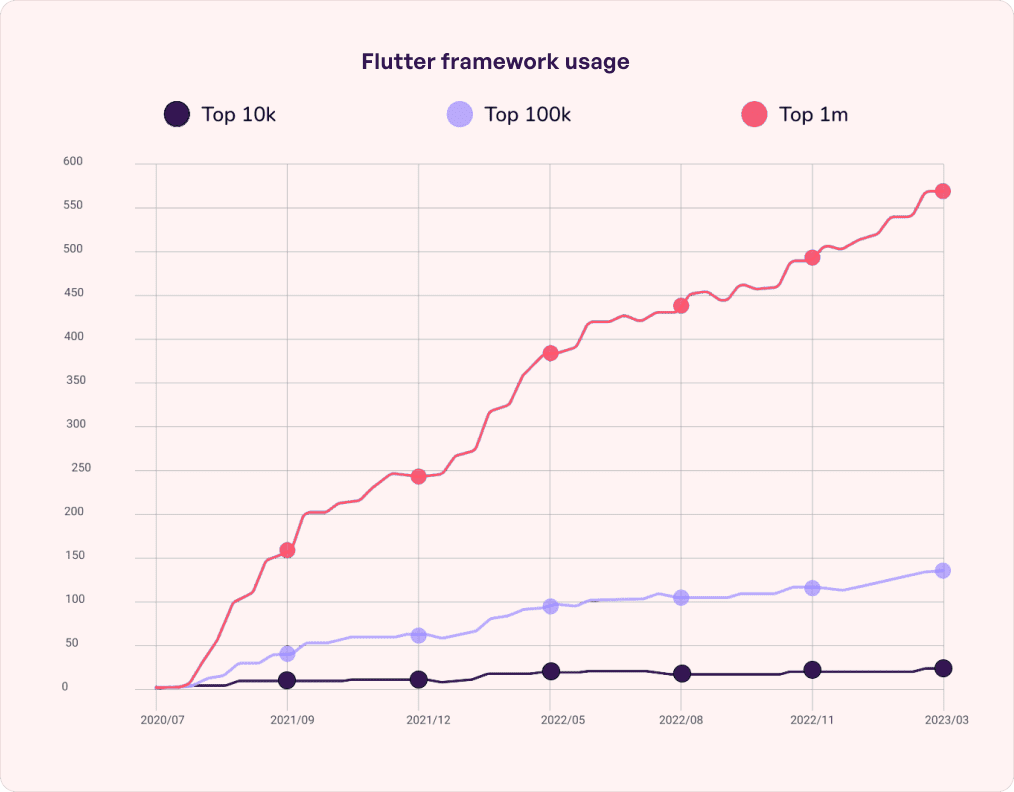
Features & Functionalities :
- A mix of JIT in development and AOT in deployment makes Flutter a reliable cross platform framework. Further, it is substantially quicker since no bridge is required to connect its code to native elements. This would otherwise slow down the process.
- Allows developers to make code changes and view the results without restraining the application due to its Hot Reload functionality.
- Has a widget-focused architecture – everything from buttons to screens instead of relying on the browser technology.
- One feature that makes Flutter stand out is its wide range of hardware APIs which is uncommon among other frameworks.
- Ensures platform-specific refinements to offer native-like performance.
Key benefits :
- Promises high-end transparency in the supply chain.
- Ensures faster app transitions and animations.
- The time-to-market is fast.
- Helpful in creating larger apps.
Loopholes
However, just like other cross platform development tools, Flutter has a few loopholes too. This includes creating weighty apps which is an issue for users with low device space. No third-party libraries can also be a cause of concern.
2. React Native
Built on JavaScript, this is an open-source cross platform app development framework that was initially launched by Meta in 2015. React Native has a single codebase which ensures no specialization is required. The developers’ community of this framework is quite active and puts in efforts to build a treasure trove of exceptional resources, tools, plugins, and libraries. This helps deliver responsive touch gestures, improvisions, seamless animations, and a quick development experience.
Features & Functionalities :
- A Fast Refresh or hot reloading feature allows developers to see real-time issues and edit components right away.
- It uses toolkits like Expo with ready-to-use integrations with hardware, over-the-air updates, and pre-built UI elements.
- The framework is easy to adopt for anyone who has worked with React Native before since it uses JavaScript.
- Flipper, with network inspector and interactive layout inspector, is enabled by default in versions 0.62 and later. This helps in super fast debugging in Android and iOS applications.
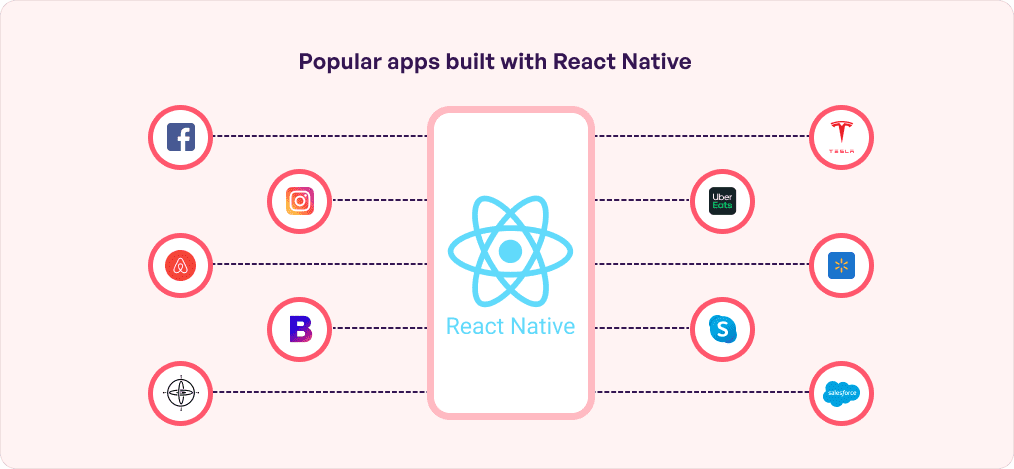
Key benefits :
- Helps build responsive and user-friendly interfaces.
- Highly compatible with plugins like Meta, Walmart, and Bloomberg.
- Reduces development time since separate codes are not required.
- Offers a native-like feel to smartphone applications
Loopholes
The UI performance of React Native is weak. Further, it does not support heavy processing and is slower to add the latest features when compared to other cross platform app development frameworks.
3. Node.js
Node.js is a historical framework with more than 6.3 million US websites being powered by it. Developers can use it for both frontend and backend and is a popular tool for all kinds of projects. Businesses that are looking for spectacular performance and speed can consider developing cross platform apps with Node.js.
For instance, Netflix, Uber, NASA, PayPal, Twitter (X), and LinkedIn are based on this framework right from their inception. It is also known for managing high traffic and thus boosting the expansion of businesses. JavaScript is the only language supporting Node.js but compile-to-JS is also available. Its’ ‘event-driven architecture’ is also capable of asynchronous I/O.
Features and functionalities :
- The JavaScript environment ensures a single thread to manage all app requests.
- Eliminates the need for multiple teams of developers to save time and money.
- Allows the integration of APIs and a host of third-party libraries.
- Constantly evolving and improving to keep up with new framework trends, upgrades, and innovations.
- Designed with real-time and push-based architecture making Node.js ideal for conventional websites.
Key benefits :
- The loading time is quite less, helping developers conserve 60% of it.
- The data processing is extremely powerful making it perfect for dynamic apps.
- Applications can be scaled both horizontally and vertically.
- High-performance ability is useful for supercharged apps with overexpanded cycles.
Loopholes
Node.js loses to other cross platform app development tools due to its inability to process heavy CPU-intensive tasks. This is because the node is blocked when a heavy task runs.
4. NativeScript
NativeScript relies on JavaScript and this open-source framework was initially launched in 2014 by Progress. It also uses other cross-platform app development languages like TypeScript, Vue, Capacitor, Ionic, Angular, and Svelte. NativeScript is a single-threaded model since it offers quick access to the native APIs. It is ideal for businesses of all size and scope, especially the ones that require readily built plug-ins . That’s why popular both big and small brands like PUMA, Breethe, Deloitte Digital, Checkpoint Curly, and Aura CO2 have deployed it for their respective apps.
Features & Functionalities :
- Allows developers to reuse plugins from NPM for projects since it offers all APIs.
- Offers a handful of pre-built templates. So, no need for third-party solutions.
- It also delivers a smooth and responsive user experience.
- Offers access to a plethora of tools, libraries, and resources.
- Allows developers to access a device’s capabilities like camera and geolocation.
Key Benefits :
- Performance is better than other web-based frameworks.
- Simple yet exciting and visually appealing UI.
- Uses just-in-time (JLT) and ahead-of-time (AOT) compilations to optimize performance.
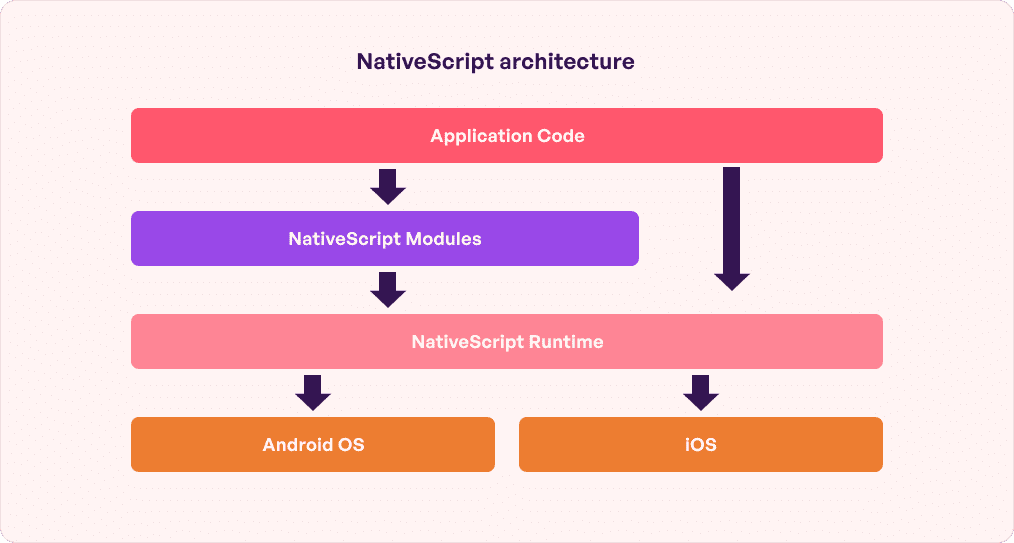
Loopholes
NativeScript is not a good choice if you are looking for superior performance quality. Further, although it does have plug-ins, they are quite selective. The resources are few as well with less support. Building 3D animations could also be difficult with NativeScript.
5. .Net Maui (Xamarin)
Microsoft officially concluded Xamarin support on May 1, 2024. The toolkits are presently merged into .NET and thus emerged as .Net Maui. It uses cross platform app development languages like C#, CSS, JavaScript, and .Net. It allows developers to use 90% of the code for building an app for three platforms: Android, iOS, and Windows. Businesses that wish to focus more on functionality rather than on user experience and appearance can pick .Net Maui. It is also ideal for startups and enterprises that want to scale their business in the .NET stack. For instance, apps like FreshDirect, Insightly, Storyo, and XamarinTV were built using this framework.
Features and functionalities :
- Supports C++ and Object-C libraries which lets developers reuse several Java or C++-encrypted codebases.
- The source code can be modified with the hot reload feature when the app is running.
- Offers a considerable set of hardware APIs to improve any app.
- MVU pattern and Blazor framework are supported along with rich UI components.
Key benefits :
- Developers who worked with Xamarin Forms can easily cope with .NET Maui.
- Offers cross-platform APIs for accessing accelerometer and GPS.
- .Net Maui’s kernel does not run on bridges which improves performance.
- Has an impressive community of Microsoft Q&A and Stack Overflow.
Loopholes
Apps built with .NET Maui can be quite bloated due to the big size. Further, it is a new technology that lacks essential controls. This leads to slower release cycles when compared to the other cross platform app frameworks.
6. Ionic
Ionic is a versatile, open-source toolkit that uses CSS, JavaScript, and HTML for developing cross platform apps. Businesses looking for highly interactive apps can consider this framework. This is because Ionic is known for its rich pre-built themes and beautiful SaaS UI components. For instance, apps like Untapped, Shipt, and Pacifia are built with Ionic. Enterprise-level projects are also made possible with Ionic due to fantastic integrations and support.
Although Ionic and Ionic Framework are used interchangeably, they are not the same. While Ionic is a comprehensive ecosystem of tools for building apps, Ionic framework is the platform that is built on top of Angular.
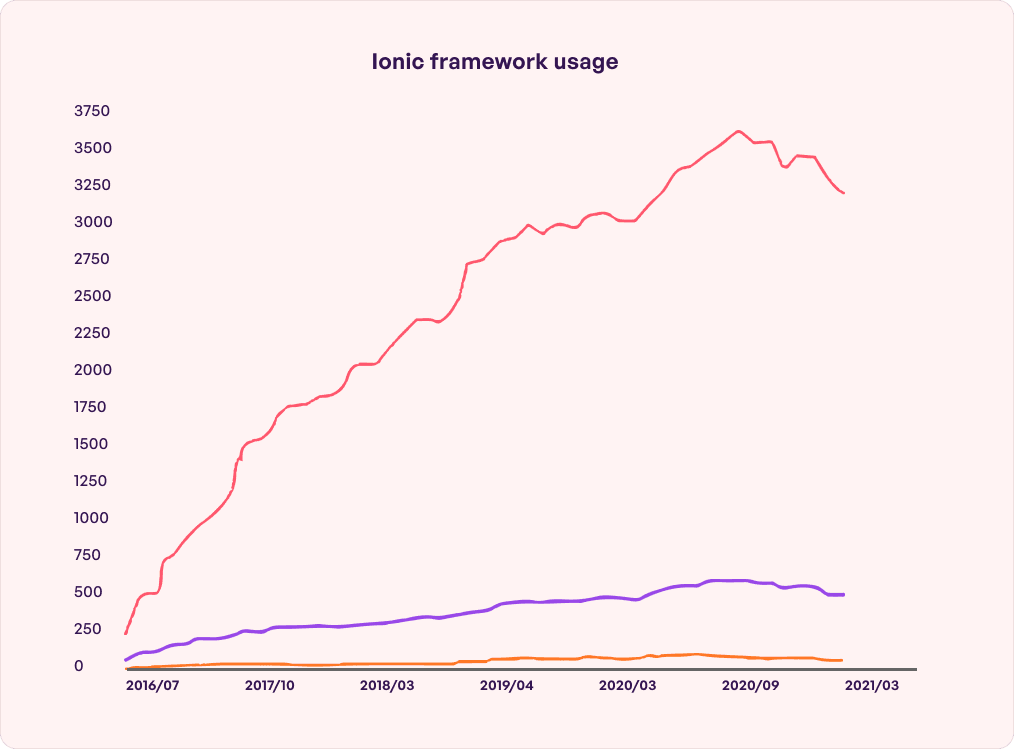
Features and functionalities
- Every UI element is customizable and reusable so developers can create unique UP components and use them across different parts of an app.
- Iconic comes with its command-line interface which helps it build applications.
- It has React, Vue, and Angular integrations, besides the one mentioned above.
- Offers a combination of Ahead-of-Time (AOT) and lazy loading time to reduce start-up time.
- Relies on basic web technologies for creating apps.
Key benefits:
- A strong Ionic cross platform development framework community ensures vast documents for help, if needed.
- The framework is highly interactive which is much like native platforms.
- Offers huge options when it is about UI design.
- Can be easily extended with additional features and functions.
Loopholes
Ionic’s access to hardware APIs is limited since the framework is of a hybrid-web nature. Further, plenty of libraries are added because ionic depends on web tech. This increases the binary size of applications.
7. Corona SDK
Corona SDK is an open-source cross platform framework originally developed by Corona Labs Inc. It uses the powerful yet easy language Lua and is especially helpful for startups and established companies that wish to develop gaming apps. Countless games like Warcraft, Egg Baby, Fun Run 2, and Zip Zap are based on this framework. It is one of the fastest tools and is utilized for high-performing multimedia by developers. In fact, Corona SDK is the official plugin for GameAnalytics. The best part is that 95+% of the code can be reused across multiple platforms like iOS, Android, Nook, and Kindle.
Features and functionalities :
- Allows visibility into the projects of the development team for clarity.
- It is mostly built on OpenAL and OpenGL 2.0 to support rich game visuals.
- Advanced graphics, filters, and physics can be added to games within seconds.
- Comparatively easier since the framework is quite flexible.
- Berry is a fantastic tiled loader for Corona SDK that enables personalized collision shapes like rectangles and polygons.
Key benefits :
- The lightweight scripting power of Lua helps in the core optimization of Corona.
- Helps create complex and multifunctional apps in minimal time.
- Can be used in a simple way or extended to highly capable OOP.
Loopholes
Corona SDK is not meant for offline game versions unless developers use Corona Premium. Further, it runs on a single language unlike the other cross platform frameworks and may not perform well for native apps. Developers might also be unable to compile the code locally.
The future of cross-platform app development frameworks
In the next decade following 2024, cross platform frameworks will focus more on seamless integration across many more devices. They also have the responsibility of offering higher adaptability and usability on their shoulders. Further, developers will see a promising change in technology and tools with advanced capabilities. Apps will grow more powerful, easy to maintain, and of course, user-friendly.
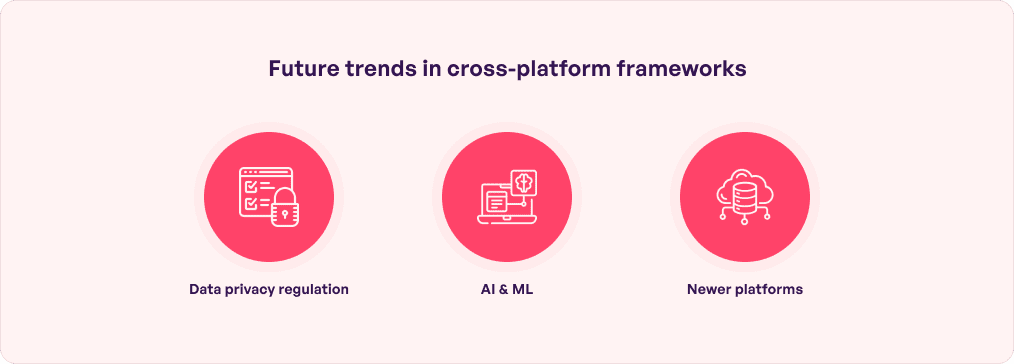
All of these will help meet the growing demands of various industries, especially the ones like farmer’s markets, engineering, and construction, where apps have not penetrated yet. Event venues like festival locations, stadiums, and concerts might also be leveraging the benefits of cross platform app development framework in the near future for broader customer base and profits.
Flutter and React Native are likely to take over the future. This is because businesses are constantly looking for ways to build apps faster without burning holes in their pockets. This could be made possible with AI and ML integrations. In the ever-changing realm of app development, these two frameworks will revolutionize tomorrow’s experience for consumers.
At Simublade, we offer exceptional mobile app development services maximizing the benefits of the top cross platform frameworks. Be it healthcare, SaaS, or fintech, we are the right fit for both startups and enterprises. Besides development, we are also an expert in maintenance, support, and modernization of your apps. Talk to us today to learn more.
FAQs
Q. What is the advantage of cross-platform application?
Ans. The top benefit of cross platform development frameworks is a wider audience across multiple devices and platforms. The app will look and feel the same everywhere with a stable and satisfying user experience.
Q. Which factors to check before hiring a cross-platform app development company?
Ans. Hire a mobile app development company that is by your side through the entire journey – from idea to mass success. For instance, Simublade offers discovery and scoping, product design, engineering, testing and quality assurance, deployment, launch, and post-launch maintenance.
Q. How do you make a mobile app cross-platform?
Ans. Developing cross platform apps will require the usage of top frameworks like Flutter, React Native, Node.js, or Ionic that make a single codebase possible. This code is used to build apps across iOS and Android applications.





